

Modern Amphibious Assault Ships
An amphibious assault ship is a type of amphibious warfare ship employed to land and support ground forces on enemy territory by an amphibious assault. The design evolved from aircraft carriers converted for use as helicopter carriers (and as a result, are often mistaken for conventional fixed-wing aircraft carriers). Modern ships support amphibious landing craft, with most designs including a well deck. Coming full circle, some amphibious assault ships now have a secondary role as aircraft carriers, supporting V/STOL fixed-wing aircraft.
The role of the amphibious assault ship is fundamentally different from that of a standard aircraft carrier: its aviation facilities have the primary role of hosting helicopters to support forces ashore rather than to support strike aircraft. However, some are capable of serving in the sea-control role, embarking aircraft like Harrier fighters for combat air patrol and helicopters for anti-submarine warfare or operating as a safe base for large numbers of STOVL fighters conducting air support for an expeditionary unit ashore. Most of these ships can also carry or support landing craft, such as air-cushioned landing craft (hovercraft) or LCUs.
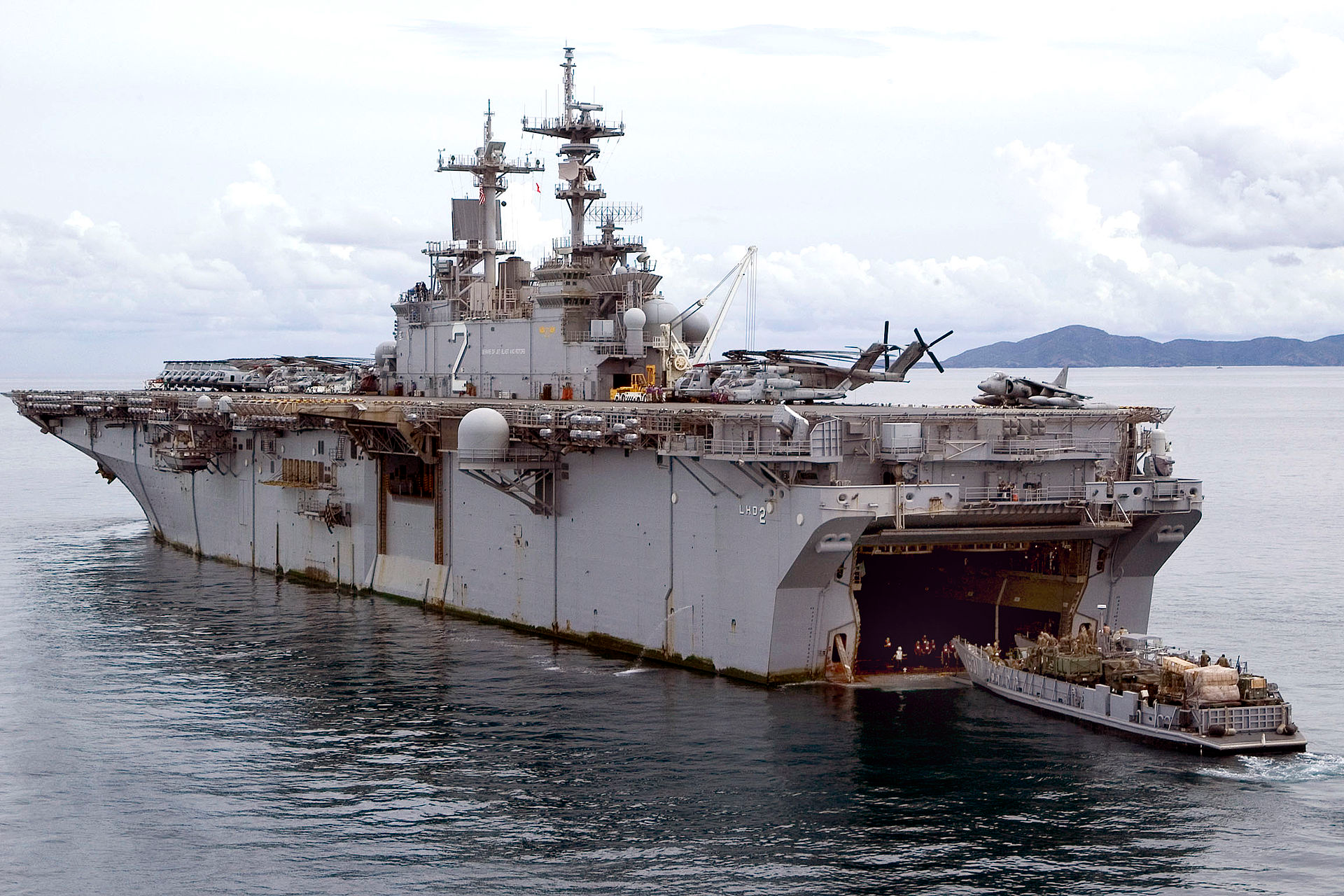
USS Essex, a Wasp-class amphibious assault ship performing a stern gate mating with a landing craft. Click on image to zoom.
The largest fleet of these types is operated by the United States Navy, including the Wasp class dating back to 1989 and the very similar America-class ships that debuted in 2014. Amphibious assault ships are also operated by the French Navy, the Italian Navy, the Republic of Korea Navy, the Royal Australian Navy, the Royal Navy, and the Spanish Navy.
The term amphibious assault ship is often used interchangeably with other ship classifications. It applies to all large-deck amphibious ships such as the Landing Platform Helicopter (LPH), Landing Helicopter Assault (LHA), and Landing Helicopter Dock (LHD).
History
Click on images below to zoom.
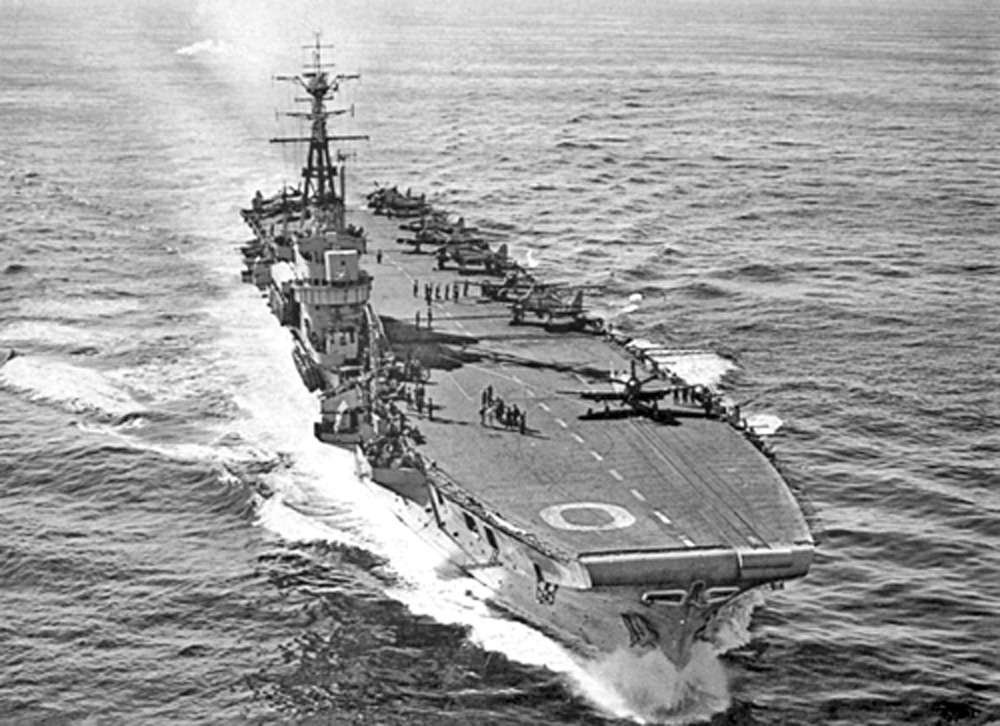
HMS Ocean, a conversion of a light aircraft carrier
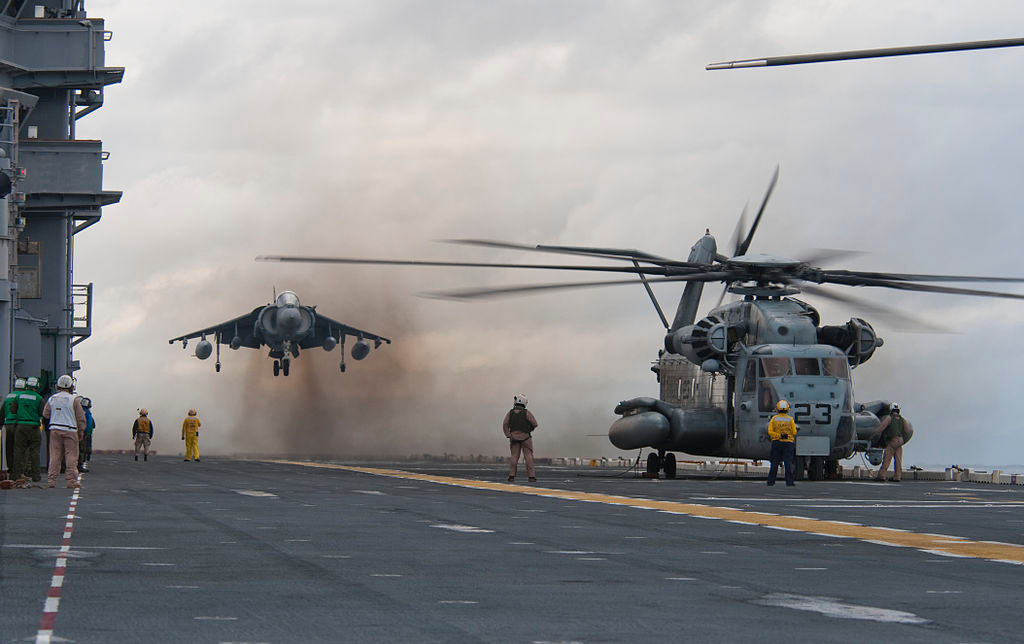
An AV-8 Harrier and MH-53 aboard USS Nassau
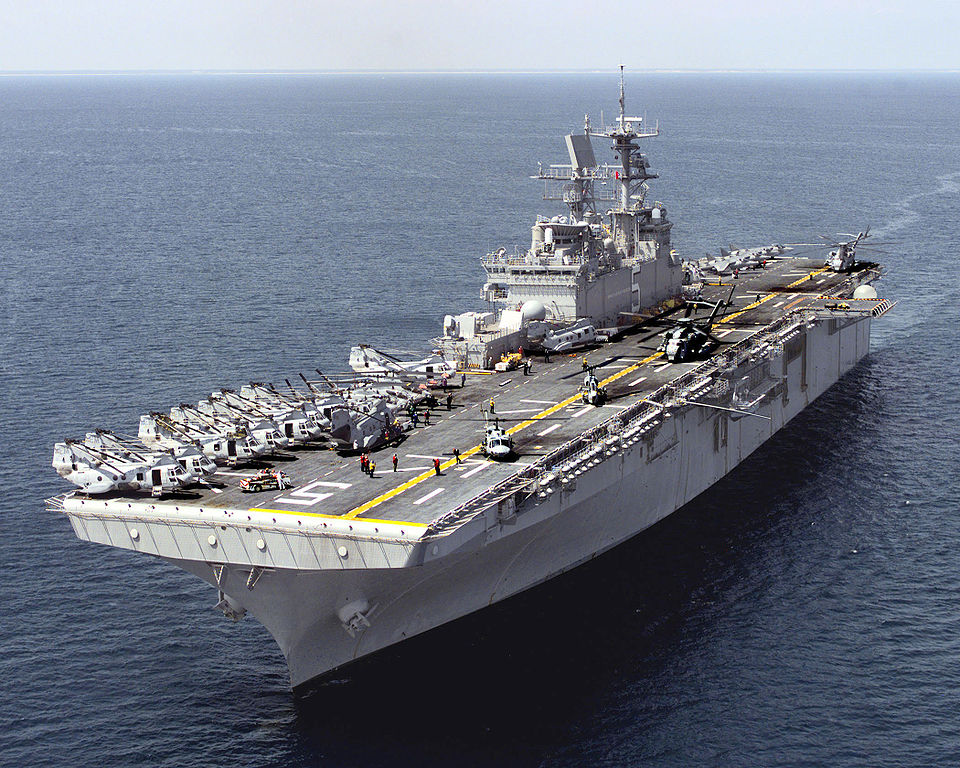
USS Bataan of the US Navy
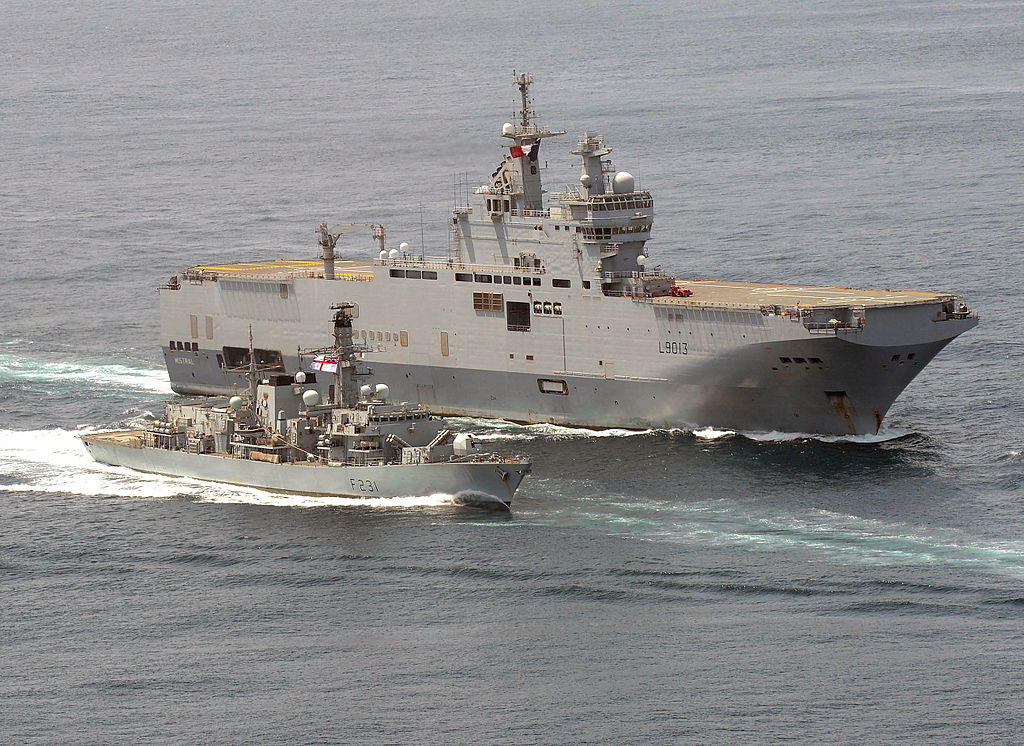
Bâtiment de Projection et de Commandement (BPC) Mistral of the French Navy with HMS Argyll off the West Africa coast
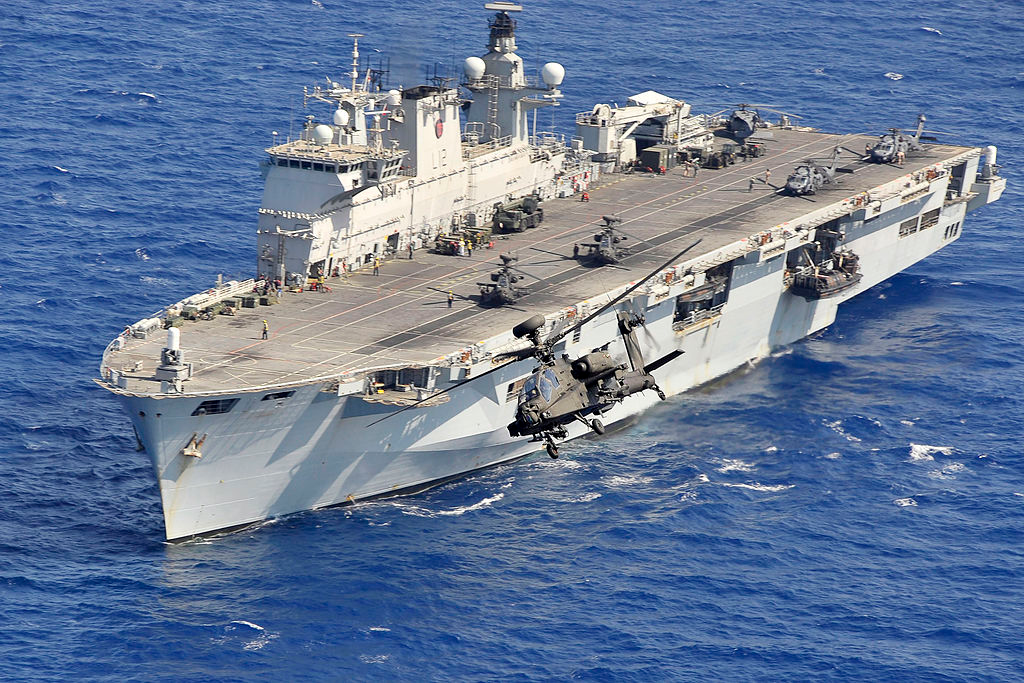
HMS Ocean of the Royal Navy
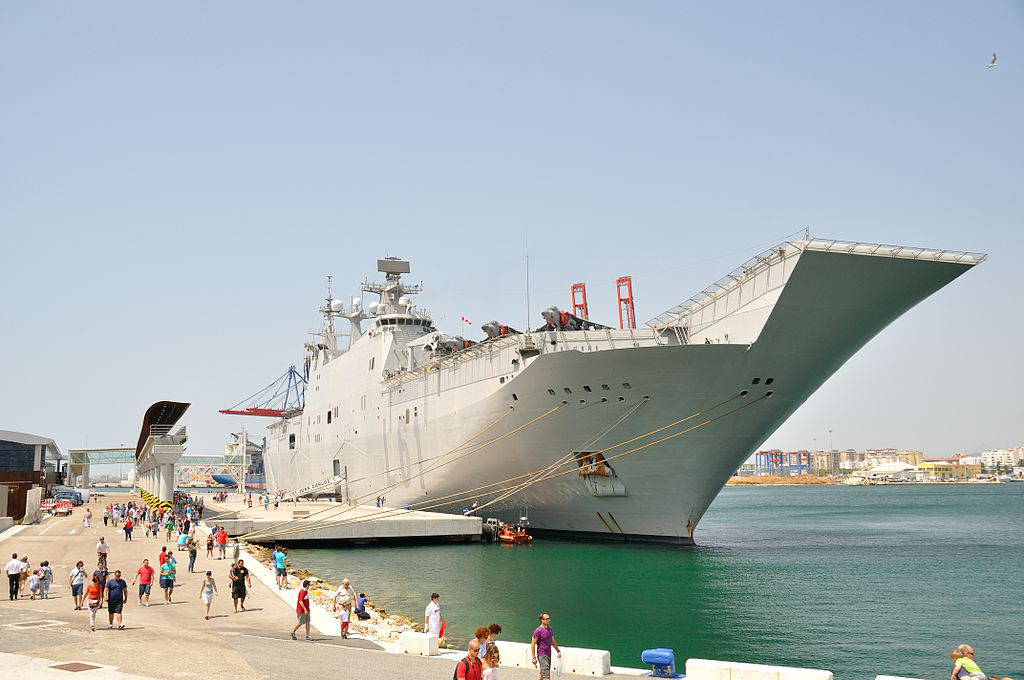
Juan Carlos I of the Spanish Navy with Harrier II attack aircraft
Source: Wikipedia
World War II
In the Pacific theatre of World War II, escort carriers would often escort the landing ships and troop carriers during the island-hopping campaign. In this role, they would provide air cover for the troopships as well as fly the first wave of attacks on the beach fortifications in amphibious landing operations. On occasion, they would even escort the large carriers, serving as emergency airstrips and providing fighter cover for their larger sisters while these were busy readying or refuelling their own planes. In addition, they would also transport aircraft and spare parts from the US to the remote island airstrips.
Post-World War II
Despite all the progress that was seen during World War II, there were still fundamental limitations in the types of coastline that were suitable for assault. Beaches had to be relatively free of obstacles, and have the right tidal conditions and the correct slope. However, the development of the helicopter fundamentally changed the equation. The first use of helicopters in an amphibious assault came during the invasion of Egypt during the Suez War in 1956. In this engagement, two British light fleet carriers, Ocean and Theseus, were converted to perform a battalion-size airborne assault with helicopters.
The techniques were developed further by American forces during the Vietnam War and refined during training exercises. The modern amphibious assault can take place at virtually any point of the coast, making defending against them extremely difficult.
Most early amphibious assault ships were converted from small aircraft carriers. As well as the two Colossus-class light aircraft carriers converted for use in the Suez War, the Royal Navy converted the Centaur-class carriers Albion and Bulwark into "commando carriers" during the 1950s. Their sister ship HMS Hermes was also converted to a commando carrier in the early 1970s, but was restored to aircraft carrier operations before the end of the 1970s. The United States Navy used three Essex-class aircraft carriers; Boxer, Princeton, and Valley Forge, and the Casablanca-class escort carrier USS Thetis Bay as the basis of their amphibious assault fleet, before constructing the five Iwo Jima-class ships specifically for the Landing Platform Helicopter role.
Later amphibious assault craft were constructed for the role. The United States Navy constructed the Tarawa class of five Landing Helicopter Assault ships, which began to enter service from the late 1970s, and the Wasp class of eight Landing Helicopter Dock ships, the first of which was commissioned in 1989. The United States Navy is also designing a new class of assault ships: the first America-class ship entered service in October 2014.
The first British ship to be constructed specifically for the amphibious assault role was HMS Ocean, which was commissioned into the Royal Navy in 1998. Other nations have built amphibious assault ships; the French Mistral class, South Korea's ROKS Dokdo, and Spain's Juan Carlos I are all currently active, while Australia has two Canberra-class ships based on the Spanish design.
Most modern amphibious assault ships have a well deck (docking well), allowing them to launch landing craft in rougher seas than a ship that has to use cranes or a stern ramp. The US Navy hull classification symbols differ among these vessels, depending on, among other things, their facilities for aircraft: a modern Landing Ship Dock (LSD) has a helicopter deck, a Landing Platform Dock (LPD) also has a hangar, and a Landing Helicopter Dock (LHD) or Landing Helicopter Assault (LHA) has a full-length flight deck with internal aviation facilities for both rotary and fixed wing craft below deck.
Design
Due to their aircraft carrier heritage, all amphibious assault ships resemble aircraft carriers in design. The flight deck is used to operate attack and utility helicopters for landing troops and supplies and on some ship types also launch and recover Harrier Jump Jets to provide air support to landing operations. STOL aircraft such as the OV-10 were sometimes deployed on and were able to perform short take-offs and landings on large-deck amphibious assault ships without needing catapults or arresting wires, although for safety and clearance reasons, the latter was most often not permitted. Landing craft are also carried, either on deck-mounted davits, or in an internal well deck.
List of Types
Landing Helicopter Assault (LHA)
• America class (United States)
• Tarawa class (United States, retired)
Landing Helicopter Dock (LHD)
• Canberra class (Australia)
• Juan Carlos I class (Spain)
• Mistral class (France and Egypt)
• Wasp class (United States)
Landing Platform Helicopter (LPH)
• Dokdo class (South Korea)
• Essex class (x3 repurposed escort carriers - United States, retired)
• Iwo Jima class (United States, retired)
• Ocean class (United Kingdom)

